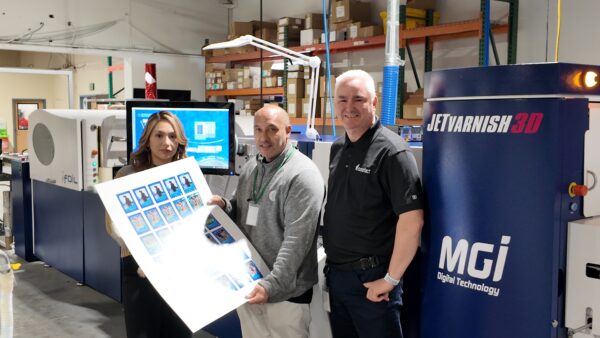The Cannata Report unveils its 2019 Women Influencers, shining the spotlight on three women who are true leaders in the industry.
Sharp’s Erica Calise, Toshiba’s Maegan Lujan, and Konica Minolta’s Victoria Ringwood are featured on the cover of our July-August summer Women Influencers issue, and in the accompanying feature article by Story Editor Sharon Esker, each shares insights about their career paths, their respective roles within their organizations, and the need to make meaningful connections.
As businesses increasingly try to differentiate themselves in a noisy marketplace, establishing meaningful connections to create a diverse and inclusive workforce has become an imperative business initiative for those companies looking to attract and retain employees. Today’s employee has evolved from working as a cog within a corporate machine to expecting more from their employers, prioritizing a company’s acceptance of who they are as a person, as well as the role they are playing in the broader marketplace, over what they are making, selling, or buying.
This year’s Women Influencers””Sharp’s Erica Calise, Toshiba’s Maegan Lujan, and Konica Minolta’s Victoria Ringwood””deeply understand the power of forging meaningful connections. As leaders within their respective companies, each of our Women Influencers have cultivated their business relationships by listening closely to the needs of their customers and team members, deftly navigating technology and demographic shifts””especially as companies manage a wider spectrum of workers across all ages from the millennial generation to baby boomers””to deliver success within their respective companies.
“Community, diversity, inclusion, social responsibility have all become a workplace challenge to overcome,” said Lujan, director of solutions and services at Toshiba America Business Solutions (TABS). “It’s the acceptance from inside your chosen family, and it’s that embracement you feel as you transition from a work-life balance to a work-life blend.”
As technology has enabled the ability to work from anywhere at any time, employees are shifting away from what had been known as a work-life balance, where there was a balance in time allocated to work and personal time, to that work-life blend Lujan is talking about. A blend is that integration of work with personal time, which means employees require work environments that support the whole employee.
“From our perspective, connectivity is a byproduct of technology and it leads to that inclusive experience,” said Lujan.
“Communication, diversity in your communication, is important because people have very different appetites attached to that. So you have to be concise in how you communicate and communicate in diverse ways to hit the biggest impact.”
Lujan firmly believes in the importance of embracing diversity and inclusion from the top down, and she espouses Toshiba’s efforts to create a sense of true belonging across all its employees through its mentoring and sponsorship programs, as well as its diversity mandate that specifies its focus on establishing a corporate culture that enables its diverse workforce to actively contribute to the business.
“Everything from the words that we choose in the job posting that unlock the AI to screen or block candidates, to the voices used in the creation of the tech, it needs to yield holistic results,” said Lujan, who spoke of the inherent bias technology has created against women, as most of today’s tech has been designed by men.
“The point is to have all voices heard, not just men or women. What our HR team did was begin working with third-party organizations to pre-screen all of our job postings and what we were outwardly advertising to a community. We wanted to be sure we did the work internally that we had the appropriate framework to support having an inclusive environment and that we were using technology to bring everybody’s voices to market, not just male or female.”
Developing a connection to bring new talent onboard is pivotal, but that connection becomes even more important once that new employee arrives at the company’s doors for work.
“Whenever we bring on a new sales rep, I sit down with them to review the org charts and territory maps, but I don’t even really talk about what my group does,” said Calise, director of government and major account marketing at Sharp. “I talk more about how Sharp works and how to navigate the process, how they can be successful in the organization. I also talk to them about what Sharp is trying to accomplish. To develop an employee into an advocate for a company means so much.”
As a 28-year veteran at Sharp, Calise serves as a valuable resource not only to the company but also to its employees.
Every company struggles with attracting and retaining talent, but having a tenured, trusted employee who excels at communicating, and understands the history of the business and its strategic goals is an asset that cannot be underestimated.
“Putting free candy in the middle of a room isn’t going to make a person want to spend more time there,” said Calise. “It’s developing a relationship with that person, spending time with that person, explaining things, and really bringing them in under your wing to a certain extent. We talk about making business sticky, but I think you also have to make your employees sticky. You want them to continue to come back and feel like they’re part of the process. If you bring them in and cultivate them, and also appreciate them for what they’re doing while they’re there, you’ll ultimately have success.”
As senior vice president of human resources at Konica Minolta, Ringwood also believes the most important component of connecting with employees is getting to know them.
“Insuring that their managers are trained to lead is the bottom line,” said Ringwood. “If dealers are going to choose one area to invest in, I would say invest in your leader training. They are the ones your employees will connect with most often, and they are the ones who will champion your company culture. Invest in training leaders how to lead and coach talent.”
In looking to attract talent, Ringwood says that women remain an untapped area in our technology-focused industry. With some of the macroeconomic trends””low unemployment rates, a reduction in migration, and the need for re-training and re-skilling workers””the opportunity to build a more inclusive and diverse work environment is ripe.
“If leaders””and when I say leaders, I mean male leaders because they really do run the majority of these businesses””could tap into, embrace, and put as much focus on driving an inclusive, diverse workplace, chances are that many of the talent gaps and innovation challenges will work themselves out by the introduction of new faces and new thoughts,” said Ringwood.
Click here to read the complete feature. Please note that in order to read the complete article, you must be a subscriber.
Access Related Content
Visit the www.thecannatareport.com. To become a subscriber, visit www.thecannatareport.com/register or contact cjcannata@cannatareport.com directly. Bulk subscription rates are also available.




